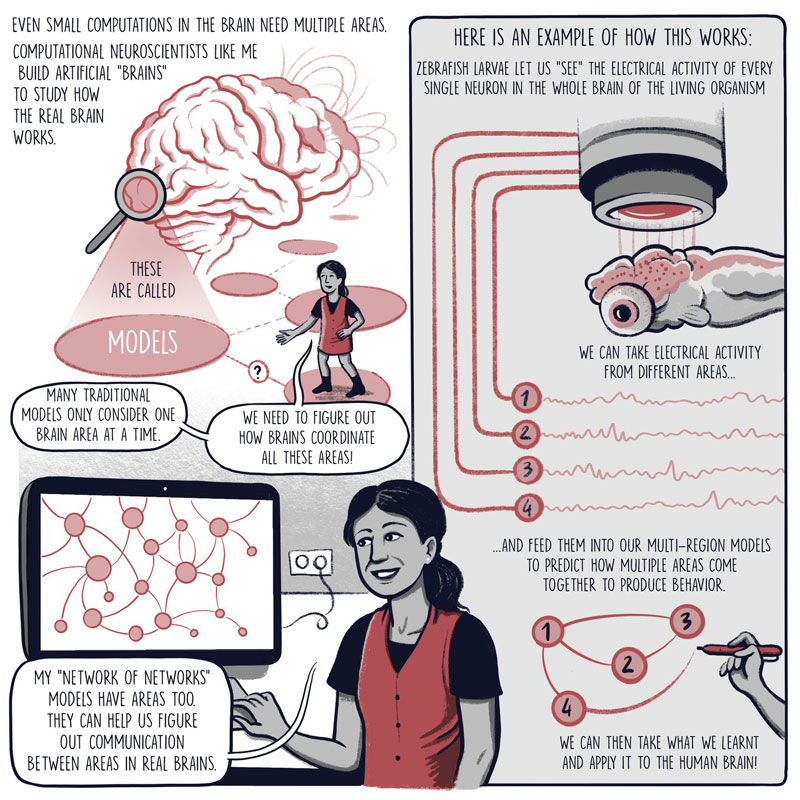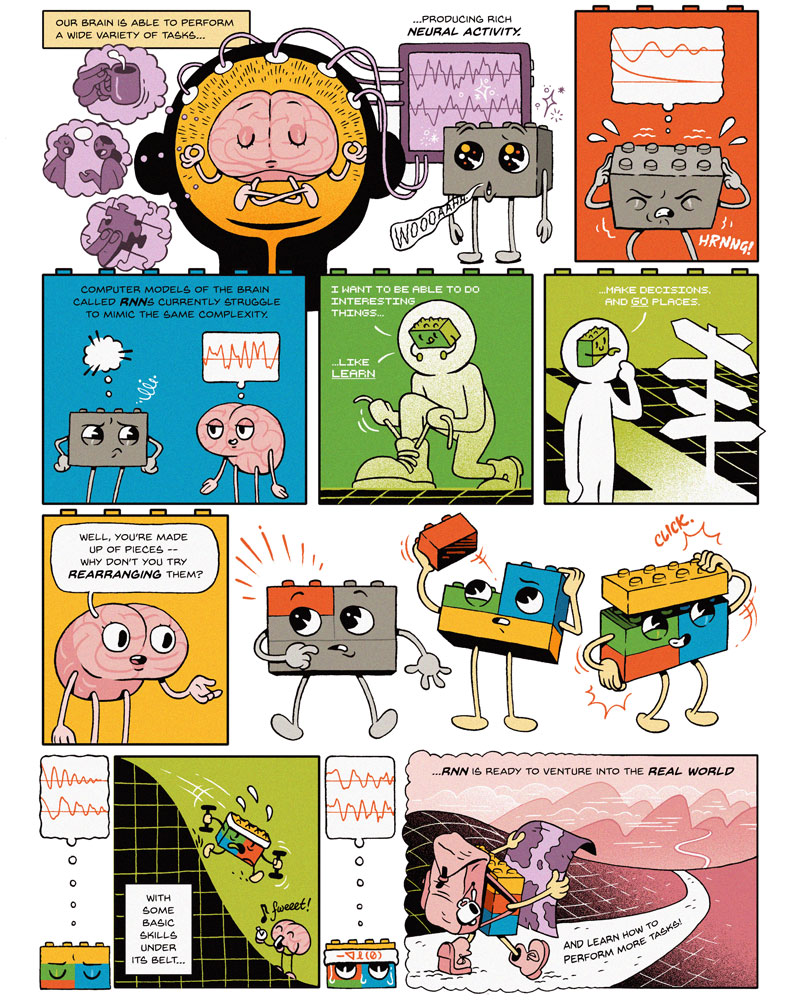Kanaka Rajan describes herself as an ever-curious, "stick-my-finger-in-the-electrical-socket kind of person" who enjoys working with her hands. Forays into engineering and experimental neuroscience led Rajan to her true calling: computational neuroscience.
- By CATHERINE CARUSO
Rajan spends her time building and manipulating models of the brain - an approach that affords her a great deal of freedom. One day she may be modeling complex social behavior in mice, and the next mapping neuronal connections in an octopus brain.
"My energy comes from that freedom; I basically see everything as a rich source of problems," said Rajan, who in September became an associate professor of neurobiology in the Blavatnik Institute at Harvard Medical School. She is also a founding faculty member of the Kempner Institute for the Study of Natural and Artificial Intelligence at Harvard University.
In a conversation with Harvard Medicine News, Rajan spoke about her wide-ranging research, her interest in science communication, and why she's excited to join the Kempner.
HMNews: What do you study and why?
Rajan: I want to understand how animals and humans learn, remember, and make decisions. To do this, I use tools from mathematics, physics, and engineering, including artificial intelligence, to build models of different brains that are as close as possible to the learning and deciding of real brains. The advantage of building a model is that we have access to all the pieces, so we can take it apart in ways we cannot take an actual brain apart, which allows us to identify core operating principles that may exist in the biological system. The overarching goal of this work is to understand the foundations of natural and artificial intelligence: What makes us sentient? What makes us "us"?
HMNews: When you talk about brain models, what do you mean?
Rajan: These are computational models, or artificial "facsimiles" of real brain circuits. Sometimes they are computer simulations and sometimes they are mathematical equations. A model is like an unformed block of clay: it consists of equations and mathematical terms that we sculpt using our knowledge of the biological system until it resembles the real brain or behavior. Then, we take that model to colleagues in experimental neurobiology and compare it to the system or behavior it was designed to copy. As a result, I work closely with experimentalists in everything that I do. It's an iterative process of going back and forth between models and experiments.

HMNews: How are you using these computational models in your research?
Rajan: One area is building models that are constrained by biological data. Experimentalists are collecting more and more data from the brain as they've progressed from recording activity in single neurons to entire brain regions. As a result, we're faced with the problem of trying to organize and make sense of huge amounts of data - which is where models come in. For example, I've worked with an experimentalist who can image the activity of neurons in the entire brain of larval zebrafish. Using this information, I built a model that essentially replicates the fish brain and we figured out how neurons communicate within and across brain areas while the animal is "just hanging out." We can use a model like mine to design new experiments, including drug screens.
HMNews: How else are you applying models in your work?
Rajan: I have another project that focuses on learning trajectories - work that is relevant to education. When we think about how we learn math, for example, we don't just memorize formulas and equations. Instead, we learn addition, then we progress to multiplication, then we build these skills into formulas and equations. In other words, we break the subject down into conceptual building blocks that we stack on top of one another. We do this until we get good at the more complex skill and at using the various concepts we learned along the way.
In my research, rather than looking at "expert" animals - mice that are already experts at navigating a maze, for example - and trying to reverse engineer their learning process, we explicitly model the entire learning trajectory. We compare our model to experimental data collected during training to ask basic questions about how tasks are broken down into conceptual building blocks. Models like mine provide a roadmap for how animals learn different tasks, which we hope will help us understand how humans learn subjects such as math and music, and how to improve learning across domains. This may be relevant for people with traumatic brain injuries who need to relearn basic skills.
HMNews: What new areas of research are you excited to pursue at HMS?
Rajan: I am especially excited about a more out-there project on the neural mechanisms responsible for the emergence and stabilization of social groups. Many neurobiology labs interested in social neuroscience are looking at brain activity in pairs of animals interacting. Their data sets are large and rich, but two animals can interact in only a few ways. By contrast, physicists look at collective behavior in large ensembles of animals such as flocks of birds or schools of fish. They build elegant mathematical models, but those models essentially treat each animal in a group as a particle rather than as an individual with complex behaviors.
My lab thinks there may be an optimal, more informative zone in the middle of these extremes, between three and 10 animals. People in evolutionary and developmental biology and neuroeconomics have observed that 10 seems to be the threshold for the nervous system's ability to process complex information from multiple members. We want to understand why this may be the case.
To this end, we're building computer programs that contain artificial agents - think video game avatars of animals - that we force to interact socially in different digital environments. For example, we have mouse avatars forage in an environment with trees and bushes as we add elements like predators, obstacles, or droughts. We can then ask experimentalists to run lab experiments with actual mice interacting in similar situations and compare the data.
HMNews: Do you think this project will tell us anything about humans?
Rajan: We hope to use our model to simulate human social concepts like loneliness. For example, if a mouse avatar that was social becomes isolated, does it show similar deficits that a profoundly, chronically lonely person showed during the COVID-19 pandemic? Does it now have trouble reentering society? Loneliness is an epidemic and a documented precursor to many neurologic and neurodegenerative disorders. We need to understand the neural basis of social interactions so that we can begin to develop interventions for the human condition.

HMNews: You recently joined HMS, but you will also be working at the Kempner. What attracted you to the institute?
Rajan: I came to computational neuroscience circuitously; I started off in engineering and moved to biology in graduate school, thinking that I wanted to be an experimentalist. Eventually, I realized that I wanted to be in a field that merges the two, but to do that, I needed to learn both the language of quantitative analysis and the language of biology, which took a long time. Institutions like the Kempner will speed up this process by providing the tools and a physical location where everybody can come together: animal researchers, engineers, coders, basic biologists, and people like me who have always wanted to exist between fields. The Kempner is saying to me and to the next generations of young minds that we don't care about traditional labels. We just want you to study big, interesting problems and we will teach you whatever languages you need, and provide you with whatever resources you need.
HMNews: You are also interested in science communication. Why?
Rajan: In computational neuroscience, we've created high barriers to entry because it may be convenient at times. I believe these barriers are completely made up. I've come to realize that you don't need an advanced degree in math to be a computational neuroscientist. You don't need to be the world's best programmer to quickly ramp up to a research problem. We have taken on the biggest question facing humanity - how the brain works - and we need as many brains as possible to answer it. If we keep writing inscrutable papers, we silo knowledge away from those who can help. If we don't learn how to communicate clearly in a jargon-free manner, and if we don't lower the barrier to entry, my field will miss out on promising talent and radical new ideas, including from groups that have been historically underrepresented and marginalized. How I communicate what I do to students at all levels is as important as what I do.
Visual media have been shown to increase engagement and retention of hard topics, so my lab began creating science comics. We turn content from scientific papers into comic strips that we distribute to underserved high school students, with the goal of promoting discussions about the papers. I hope that by making computational neuroscience more accessible, we can eventually help the field become more inclusive and diverse.

This interview was edited for length and clarity.






